#most of the others are actually from the cretaceous
Explore tagged Tumblr posts
Text


Fun fact: It‘s theorized that dilophosaurus may have hunted in packs of three,but even alone they would still be the apex predator of north America in the early Jurassic
#wild kratts#martin kratt#chris kratt#digital art#wild kratts au#dinosaur#dilophosaurus#wildkratts au#wild kratts fan comic#wild kratts oc#I sometimes forget that I make these comics in advance#at the time this is posted that comic strip will be a month old#one of the rare instaces of a jurassic animal that was shown in JURASSIC park#most of the others are actually from the cretaceous
76 notes
·
View notes
Text
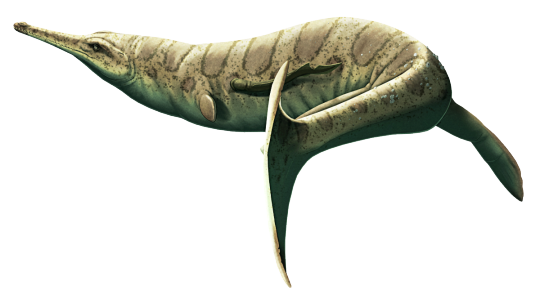
Metriorhynchids were a group of fully marine crocodyliforms known from the mid-Jurassic to the early Cretaceous of Europe and the Americas. They were the most aquatic-adapted of all known archosaurs, with streamlined bodies, smooth scaleless skin, small front flippers, larger hind flippers, and shark-like tail flukes. They may also have been endothermic, and might even have given live birth at sea rather than laying eggs.
Rhacheosaurus gracilis here was a metriorhynchid that lived in warm shallow waters around what is now Germany during the late Jurassic, about 150 million years ago. Around 1.5m long (~5'), its long narrow snout lined with delicate pointed teeth suggests it fed on small soft-bodied prey, a niche partitioning specialization that allowed it to coexist with several other metriorhynchid species in the same habitat.
Unlike most other marine reptiles metriorhynchids didn't have particularly retracted nostrils, which may have had a limiting effect on their efficiency as sustained swimmers since higher-set nostrils make it much easier to breathe without having to lift the whole head above the surface. The lack of such an adaptation in this group may be due to their ancestors having a single nasal opening formed entirely within the premaxilla bones at the tip of the snout, uniquely limiting how far it could easily shift backwards – other marine reptiles had nostrils bound by the edges of multiple different bones, giving them much more flexibility to move the openings around.
(By the early Cretaceous a close relative of Rhacheosaurus did actually evolve nostrils bound by both the premaxilla and the maxilla, and appeared to have started more significant retraction, but unfortunately this only happened shortly before the group's extinction.)
Metriorhynchids also had well-developed salt glands in front of their eyes, but the large sinuses that accommodated these glands may have made their skulls ill-suited to deep diving, being more susceptible to serious damage from pressure changes and restricting their swimming to near-surface waters only.
Preserved skin impressions in some metriorhynchid fossils show several unusual "irregularities", including curl shapes, small bumps, and cratering. It's unknown what exactly caused these marks, but they may represent scarring from external parasites such as lampreys and barnacles.
———
NixIllustration.com | Tumblr | Patreon
References:
Andrade, Marco BD, and Mark T. Young. "High diversity of thalattosuchian crocodylians and the niche partition in the Solnhofen Sea." 56th Symposium of Vertebrate Palaeontology and Comparative Anatomy, 2008. https://svpca.org/years/2008_dublin/abstracts.pdf#page=14
Séon, Nicolas, et al. "Thermophysiologies of Jurassic marine crocodylomorphs inferred from the oxygen isotope composition of their tooth apatite." Philosophical Transactions of the Royal Society B 375.1793 (2020): 20190139. https://doi.org/10.1098/rstb.2019.0139
Spindler, Frederik. "Live Birth in a Jurassic Marine Crocodile." Abstracts of the 90th Annual Meeting of the Paläontologische Gesellschaft, 2019. https://www.palaeontologie.geowissenschaften.uni-muenchen.de/pdfs/palges2019_abstracts.pdf#page=141
Spindler, Frederik, et al. "The integument of pelagic crocodylomorphs (Thalattosuchia: Metriorhynchidae)" Palaeontologia Electronica 24.2 (2021): a25. https://doi.org/10.26879/1099
Young, Mark T., et al. "Convergent evolution and possible constraint in the posterodorsal retraction of the external nares in pelagic crocodylomorphs." Zoological Journal of the Linnean Society 189.2 (2020): 494-520. https://doi.org/10.1093/zoolinnean/zlaa021
Young, Mark T., et al. "Skull sinuses precluded extinct crocodile relatives from cetacean-style deep diving as they transitioned from land to sea." Royal Society Open Science 11.10 (2024): 241272. https://doi.org/10.1098/rsos.241272
Wikipedia contributors. “Metriorhynchidae” Wikipedia, 12 Nov. 2024, https://en.wikipedia.org/wiki/Metriorhynchidae
Wikipedia contributors. “Rhacheosaurus” Wikipedia, 02 Dec. 2024, https://en.wikipedia.org/wiki/Rhacheosaurus
#science illustration#paleontology#paleoart#palaeoblr#rhacheosaurus#metriorhynchidae#thalattosuchia#crocodyliformes#crocodylomorpha#pseudosuchia#archosaur#art#marine reptile#lamprey#barnacle#parasite
546 notes
·
View notes
Text
Fossil Crocs of 2024
Another year another list of new fossil crocodilians that greatly expand our knowledge of Pseudosuchia across deep time. Happy to say that this is my third time doing this now, so I'm not going to bog you down with the details and get right into it.
Benggwigwishingasuchus
Our first entry, sorted by geological age of course, is Benggwigwishingasuchus eremicarminis (desert song fishing crocodile) from the Middle Triassic (Anisian) of Nevada. It was a member of the clade Poposauroidea, which some of you might recognize as also containing such bizarre early croc cousins like Arizonasaurus and Effigia. Also notable about Benggwigwishingasuchus is that it was found in the Fossil Hill Member of the Favret Formation. Why is that notable? Well the Fossil Hill Member preserves an environment deposited 10 km off the Triassic coastline and also yielded fossils of animals like Cymbospondylus, the giant ichthyosaur. Despite this however, Benggwigwishingasuchus shows no obvious signs of having been a swimmer or diver. Instead, its been hypothesized that it was simply foraging around the coast and might have been washed out to sea.
Artwork by Joschua Knüppe (@knuppitalism-with-ue) and Jorge A. Gonzalez
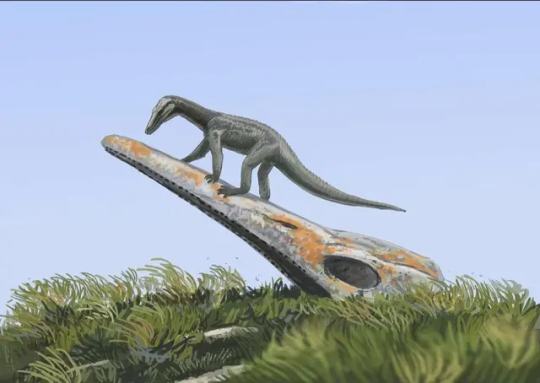
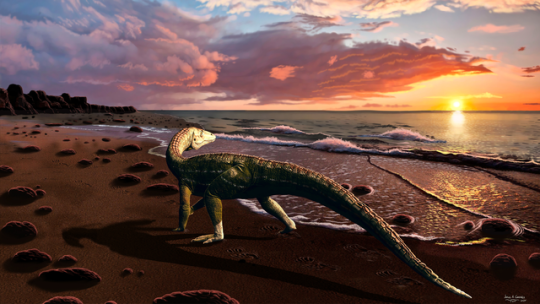
Parvosuchus
Fast forward some 5 million years to the Ladinian - Carnian of Brazil, specifically the Santa Maria Formation. Here you'll find the one new genus on the list I did not write the wikipedia page for: Parvosuchus aurelioi (Aurélio's Small Crocodile). With only a meter in length, Parvosuchus is amongst the smallest pseudosuchians of the year and a member of the aptly named Gracilisuchidae. Santa Maria was actually home to multiple pseudosuchians, including the mighty Prestosuchus (and its possible juvenile form Decuriasuchus), the small erpetosuchid Archeopelta and larger Pagosvenator and one more...
Artwork by Matheus Fernandes and Joschua Knüppe
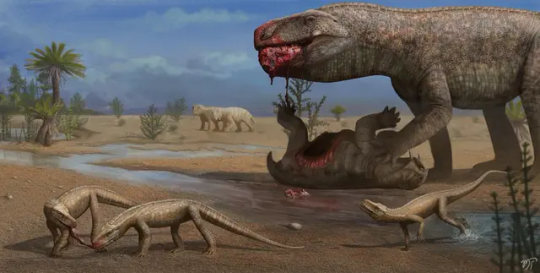

Schultzsuchus
Yup, Santa Maria has been eating good this year. Before the description of Parvosuchus, scientists coined the name Schultzsuchus loricatus (Schultz's Crocodile). Now this one's not entirely new and has long been known under the name Prestosuchus loricatus (by which I mean since 1938). What's interesting is that this new redescription suggests that rather than being a Loricatan, Schultzsuchus was actually an early member of Poposauroidea like Benggwigwishingasuchus. Even if it was no longer thought to be close to Prestosuchus, it was liekly still a formidable predator and among the larger pseudosuchians of the formation.
Artwork by Felipe Alves Elias

Garzapelta
Our last Triassic pseudosuchian and our only aetosaur of the year came to us in the form of Garzapelta muelleri (Mueller's Garza County Shield). It comes from the Late Triassic (Norian) Cooper Canyon Formation of, you guessed it, Garza County, Texas. As an aetosaur, the osteoderms are already regarded as diagnostic, tho unlike some other recent examples there is a little more material to go off from. It's still primarily osteoderms, but at least a good amount and even some ribs.
Artwork by Márcio L. Castro

Ophiussasuchus
Our only Jurassic newcommer is Ophiussasuchus paimogonectes (Paimogo Beach Swimmer Portuguese Crocodile), but arguably you couldn't find a better posterchild for Jurassic crocodyliforms. This new lad is a goniopholidid from the Kimmeridgian to Tithonian Lourinhã Formation, yup, Europe's Morrison. It's anatomy is perhaps not the most exciting, like other goniopholidids it had a flattened, very crocodilian-esque snout and was likely semi-aquatic like its relatives.
Artwork by @manusuchus and Joschua Knüppe


Enalioetes
Another quintessential group of Jurassic crocodyliforms are the metriorhynchoids, however, 2024's only new addition to this clade was actually Cretaceous, specifically from the earliest Cretaceous (Valanginian) of Germany. Like Schultzsuchus, Enalioetes schroederi (Schroeder's Sea Dweller) is new in name only, as fossil material has been found at the latest in 1918 and given the name Enaliosuchus "schroederi" in 1936. This kickstarted a whole series of taxonomic back and forth until the recent redescriptoin finally just gave it a new name and settled things (for now). Looking back I realize that I really need to take the time and fix up the Wikipedia page. Tho I've written its current status, I was kinda limited by being on vacation and never dived into the description section.
Artwork by Joschua Knüppe and Jackosaurus
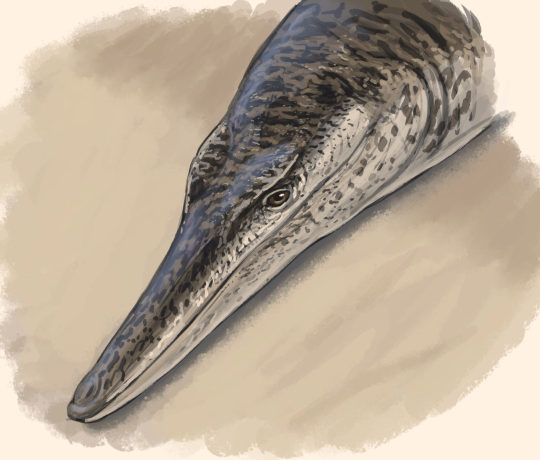

Varanosuchus
Another Early Cretaceous crocodyliform is Varanosuchus sakonnakhonensis (Monitor Lizard Crocodile from the Sakon Nakhon Province), described from Thailand's Sao Khua Formation. It lived around the same time as Enalioetes, but otherwise couldn't have been more different. Where Enalioetes was fully marine, Varanosuchus was more a land dweller as evidenced by the deep skull and long, slender legs. At the same time, some other features, like its more robust limbs compared to its kin, might suggest that Varanosuchus could have still spent some time in the water like some modern lizards. Tho one might be reminded of Parvosuchus from earlier, Varanosuchus is a much more recent example of small terrestrial croc-relatives, the atoposaurids, which are much closer to todays crocodiles and alligators.
Artwork once again by Manusuchus

Araripesuchus manzanensis
Yet another example of a small, gracile land "crocodile" comes to us in the form of Araripesuchus manzanensis (Araripe Basin Crocodile from the El Manzano Farm). And once again, it belonged to a completely different group, this time the notosuchian family Uruguaysuchidae. Now Araripesuchus is well known as a genus, in part due to the work of Paul Sereno and Hans Larsson (who popularized the names "dog croc" and "rat croc" for two species). Tangent aside, A. manzanensis is known from the upper layers of Argentina's Candeleros Formation, corresponding to the Cenomanian (earliest Late Cretaceous). The same locality also yielded A. buitreraensis, from which A. manzanensis can be distinguished on account of its blunt molariform teeth in the back of its jaw. This dentition, which corresponds to a durophageous diet of hardshelled prey, could explain how it coexisted with the related A. buitrensis at the same locality, allowing the two to occupy different niches. There is a neat little animation done for this animal you can watch here.
Artwork by Gabriel Diaz Yantén
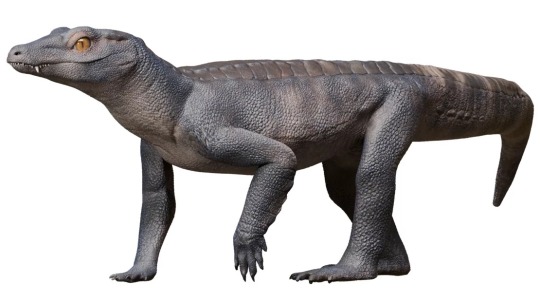
Caipirasuchus catanduvensis
We're staying in South America but moving to Brazil's Adamantina Formation for our next entry: Caipirasuchus catanduvensis (Caipiras Crocodile from Catanduva). This one is a little more recent, tho the age of the Adamantina Formation is a bit of a mess far as I can tell, ranging anywhere from the Turonian to the Maastrichtian. One could also argue that C. catanduvensis is part of the "lanky small croc club" that Parvosuchus, Varanosuchus and A. manzanensis belong to, but I feel that the very short snout helps it stand out from that bunch more easily. Anyhow, Caipirasuchus catanduvensis is a member of Sphagesauridae, related to Armadillosuchus, and herbivorous. What's really interesting tho is that the internal anatomy suggests the presence of resonance chambers not unlike that of hadrosaurs, possibly suggesting that these animals were quite vocal. This could also explain why baurusuchids appear to have had very keen hearing.
Artwork by Joschua Knüppe and Guilherme Gehr
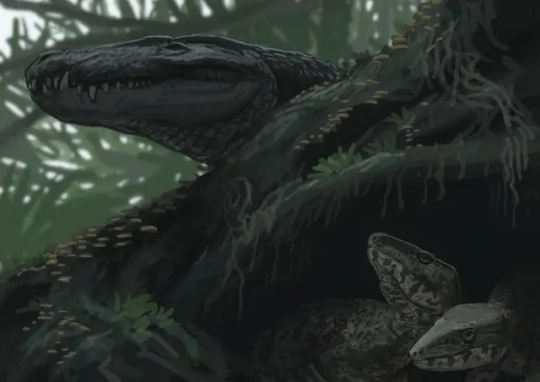

Epoidesuchus
We're staying in the Adamantina Formation for our last Mesozoic croc of the year, Epoidesuchus tavaresae (Tavares' Enchanted Crocodile). Tho also a Notosuchian like Araripesuchus and Caipirasuchus, this one belongs to the family Itasuchidae (or the subfamily Pepesuchinae depending on who you ask), which stand out as being rare examples of semi-aquatic members of this otherwise largely terrestrial group. Epoidesuchus was fairly large for its kin and had long, slender jaws. Like I said, Epoidesuchus and its relatives were likely more semi-aquatic than other notosuchians, something that might explain the relative lack of semi-aquatic neosuchians across Gondwana. They aren't absent mind you, but noticably rarer than they are in the northern hemisphere.
Artwork by Guilherme Gehr

And thus we move into the Cenozoic and towards the end our or little list. From here on out, say goodbye to Notosuchians or other weird crocodylomorphs and get ready for Crocodilia far as the eye can see.
Ahdeskatanka
The first Cenozoic croc we got is Ahdeskatanka russlanddeutsche (Russian-German Alligator), which despite its name comes from North Dakota, specifically the Early Eocene Golden Valley Formation. Ahdeskatanka is similar to many early alligatorines like Allognathosuchus in being small with rounded, globular teeth that suggest that it fed on hardshelled prey. This would have definitely helped avoid competition in the Golden Valley Formation, which also housed a second, similar form not yet named, a large generalist with a V-shaped snout similar to Borealosuchus and the generalized early caiman Chrysochampsa, also large but with a U-shaped snout.
Artwork by meeeeeeee

Asiatosuchus oenotriensis
We had an alligatoroid, so now its time for a crocodyloid. Asiatosuchus has been recognized from the Late Eocene Duero Basin of Spain for a while now, but now we have a name: Asiatosuchus oenotriensis (Asian Crocodile Belonging To The Land Of Wine). Asiatosuchus is a complex genus, most often not really forming a monophyletic clade and likely representing several distinct or at least successive taxa that form the "Asiatosuchus-like complex". Within this complex, A. oenotriensis is thought to have been close-ish to Germany's Asiatosuchus germanicus.
Artwork by Manusuchus

Sutekhsuchus
Rounding out the trio of major crocodilian clades is Sutekhsuchus dowsoni (Set's Crocodile/God of Deception Crocodile), representing our only gavialoid of the year. Originally described as Tomistoma dowsoni in 1920 based on fossil remains from the Miocene of Egypt, Sutekhsuchus has been at times regarded as distinct and at other times lumped into Tomistoma lusitanica. It was one of several early gavialoids to inhabit the coast of the Tethys during the Miocene and appears to have been most closely related to the genus Eogavialis, clading together just outside of the American and Asian gharials. A fun little personal anecdote, I prematurely learned about this one due to a friend highlighting the name in a study on Eogavialis. Never having heard of "Sutekhsuchus" I took to google scholar, where I found a single result: a reference to the then unpublished description, which naturally I ended up eagerly awaiting.
Artwork by Manusuchus and Joschua Knüppe
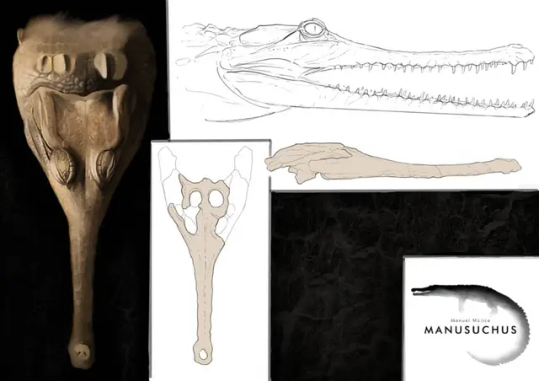
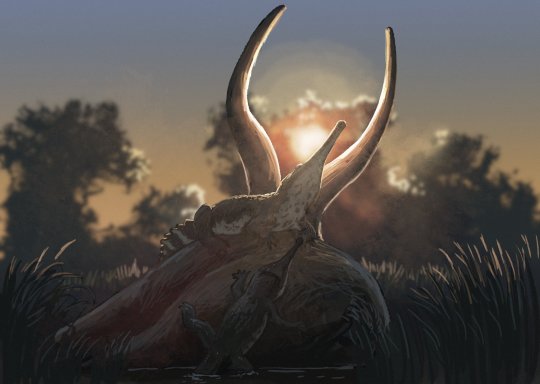
Paranacaiman
Two more and we're done. First, completely arbitrarily, Paranacaiman bravardi (Bravard's Caiman from Parana) from the Miocene Ituzaingo Formation of Argentina. Material of this genus has originally been referred to Caiman lutescens, described in 1912 but now considered a nomen dubium. Paranacaiman is known from limited material only, just the skull table, but that would indicate a "huge" animal. My personal scaling recovered a size of almost 5 meters in length, similar to large black caimans today.
Once again, credit to me

Paranasuchus
Last but not least, Paranasuchus gasparinae (Gasparini's Crocodile from Parana). Coming from the same deposits as Paranacaiman, this one too has been known as a species of Caiman for some time before being assigned its own genus, though it at least got to retain its old species name. Alas, I have not scaled it myself, tho its material is at least more extensive than that of Paranacaiman, including even parts of the snout. A little nitpick because I don't have much to say, but I personally think the name was ill conceived. On its own both Paranacaiman and Paranasuchus are fine names don't get me wrong, but together, coined by the same authors in the same study no less, they strike me as needlessly confusing to non experts. Both are caimans, both are from Parana, so the distinction between "Parana Caiman" and "Parana Crocodile" is entirely arbitrary and doesn't really distinguish them. Not helped by the fact that they are even closely related in the original description. Other than that tho another good addition to our understanding of fossil crocs.
No artwork on this one, but fossil material from Bona et al. 2024

And that wraps up 2024. I hope This post, or my posts throughout the year or even my work on Wikipedia has helped to make these fascinating animals just a little bit more approachable and a massive thanks to all the artists who took their time to create fantastic pieces featuring these incredible animals. Special shout outs to Manusuchus, who diligently illustrated a lot of the featured animals and Joschua Knüppe, who had to listen to me suggest Ahdeskatanka every Sunday for about two months straight now.
Fossil Crocs of 2023
Fossil Crocs of 2022
#paranasuchus#paranacaiman#ahdeskatanka#sutekhsuchus#ophiussasuchus#epoidesuchus#caipirasuchus#araripesuchus#enalioetes#parvosuchus#benggwigwishingasuchus#schultzsuchus#garzapelta#varanosuchus#paleontology#prehistory#palaeoblr#long post#fossil crocs of 2024#paleo#paleonotlogy#crocodilia#crocodylomorpha#pseudosuchia#fossils#2024
260 notes
·
View notes
Text
I recently found out a show I liked is 10 years old now so to not be the oldest thing on this blog I'm talking coelacanths for Wet Beast Wednesday. Coelacanths are rare fish famed for being living fossils. While that term is highly misleading, it is true that coelacanths are among the only remaining lobe-fined fish and were thought to have gone extinct millions of years ago before being rediscovered in modern times.
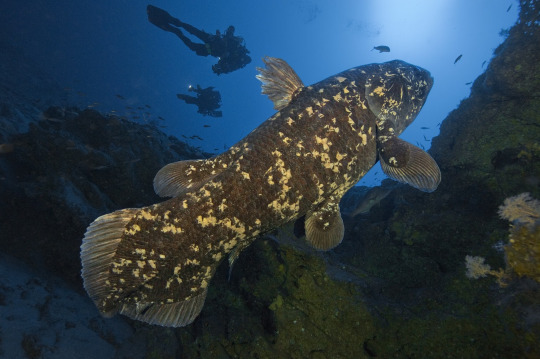
(image id: a wild coelacanth. It is a large, mostly grey fish with splotches of yellowish scales. Its fins are attached to fleshy lobes. It is seen from the side, facing the top right corner of the picture)
Coelacanth fossils had been known since the 1800s and they were believed to have gone extinct in the late Cretaceous period. That was until December 1938, when a museum curator named Marjorie Courtenay-Latimer was informed of an unusual specimen that had been pulled in by local fishermen. After being unable to identify the fish, she contacted a friend, ichthyologist J. L. B. Smith, who told her to preserve the specimen until he could examine it. Upon examining it early next year, he realized it was indeed a coelacanth, confirming that they had survived, undetected, for 66 million years. Note that fishermen living in coelacanth territory were already aware of the fish before they were formally described by science. Coelacanths are among the most famous examples of a lazarus taxon. This term, in the context of ecology and conservation, means a species or population that is believed to have gone extinct but is later discovered to still be alive. While coelacanths are among the oldest living lazarus taxa, they aren't the oldest. They are beaten out by a genus of fly (100 million years old) and a type of mollusk (over 300 million years old).

(image: a coelacanth fossil. It is a dark brown imprint of a coelacanth on white rock. Its skeleton is visible in the imprint)
Coelacanths are one of only two surviving groups of lobe-finned fish along with the lungfishes. Lobe-finned fish are bony fish notable for their fins being attached to muscular lobes. By contrast, ray-finned fish (AKA pretty much every fish you've ever heard of that isn't a shark) have their fins attached directly to the body. That may not sound like a big difference, but it actually is. The lobes of lobe-finned fish eventually evolved into the first vertebrate limbs. That makes lobe-finned fish the ancestors of all reptiles, amphibians, and mammals, including you. In fact, you are more closely related to a coelacanth than a coelacanth is to a tuna. Coelacanths were thought to be the closest living link to tetrapods, but genetic testing has shown that lungfish are actually closer to the ancestor of tetrapods.
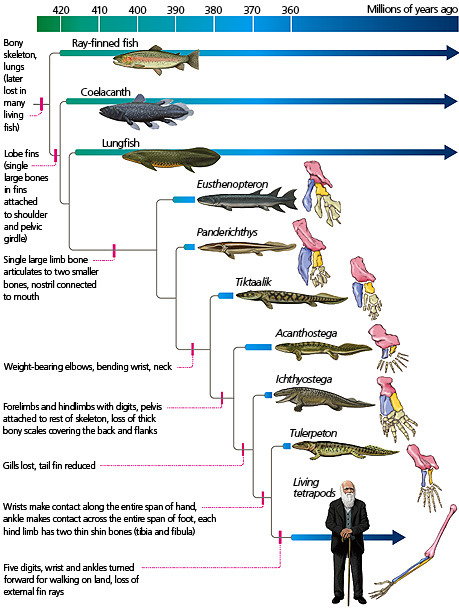
(image id: a scientific diagram depicting the taxonomic relationships of early lobe-finned fish showing their evolution to proto-tetrapods like Tiktaalik and Ichthyostega, to true tetrapods. Source)
There are two known living coelacanth species: the west Indian ocean coelacanth (Latimeria chalumnae) and the Indonesian coelacanth (L. menadoensis). Both are very large fish, capable of exceeding 2 m (6.6 ft) in length and 90 kg (200 lbs). Their wikipedia page describes them as "plump", which seems a little judgmental to me. Their tails are unique, consisting of two lobes above and below the end of the tail, which has its own fin. Their scales are very hard and thick, acting like armor. The mouth is small, but a hinge in its skull, not found in any other animal, allows the mouth to open extremely wide for its size. In addition, they lack a maxilla (upper jawbone), instead using specialized tissue in its place. They lack backbones, instead having an oil-filled notochord that serve the same function. The presence of a notochord is the key characteristic of being a chordate, but most vertebrates only have one in embryo, after which it is replaced by a backbone. Instead of a swim bladder, coelacanths have a vestigial lung filled with fatty tissue that serves the same purpose. In addition to the lung, another fatty organ also helps control buoyancy. The fatty organ is large enough that it forced the kidneys to move backwards and fuse into one organ. Coelacanths have tiny brains. Only about 15% of the skull cavity is filled by the brain, the rest is filled with fat.
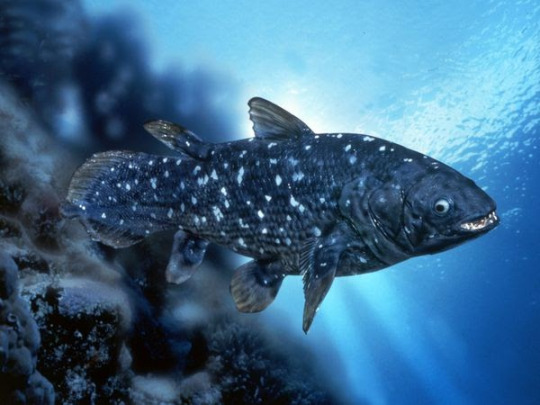
(image id: a coalacanth. It is similar to the one on the above image, but this one is blue in color and the head is seen more clearly, showing an open mouth and large eye)
One of the reasons it took so long for coelacanths to be rediscovered is their habitat. They prefer to live in deeper waters in the twilight zone, between 150 and 250 meters deep. They are also nocturnal and spend the day either in underwater caves or swimming down into deeper water. They typically stay in deeper water or caves during the day as colder water keeps their metabolism low and conserves energy. While they do not appear to be social animals, coelacanths are tolerant of each other's presence and the caves they stay in may be packed to the brim during the day. Coelacanths are all about conserving energy even when looking for food. They are drift feeders, moving slowly with the currents and eating whatever they come across. Their diet primarily consists of fish and squid. Not much is known about how they catch their prey, but they are capable of rapid bursts of speed that may be used to catch prey and is definitely used to escape predators. They are believed to be capable of electroreception, which is likely used to locate prey and avoid obstacles. Coelacanths swim differently than other fish. They use their lobe fins like limbs to stabilize their movements as they drift. This means that while coelacanths are slow, they are very maneuverable. Some have even been seen swimming upside-down or with their heads pointed down.
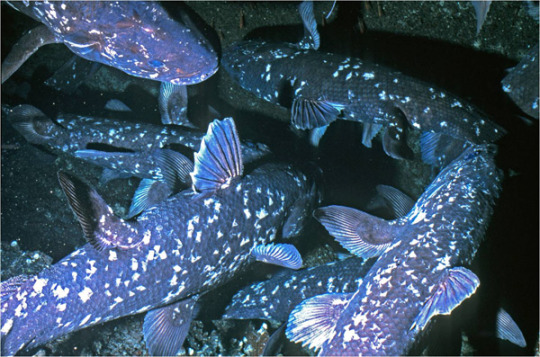
(image: an underwater cave wilt multiple coelacanths residing in it. 5 are clearly visible, with the fins of others showing from offscreen)
Coelacanths are a vary race example of bony fish that give live birth. They are ovoviviparous, meaning the egg is retained and hatches inside the mother. Gestation can take between 2 and 5 years (estimates differ) and multiple offspring are born at a time. It is possible that females may only mate with a single male at a time, though this is not confirmed. Coelacanths can live over 100 years and do not reach full maturity until age 55. This very slow reproduction and maturation rate likely contributes to the rarity of the fish.
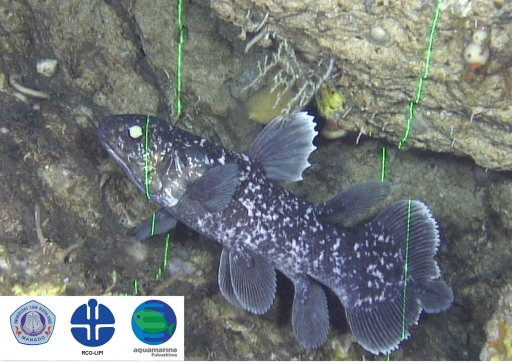
(image: a juvenile coelacanth. Its body shape is the same as those of adults, but with proportionately larger fins. There are green laser beams shining on it. These are used by submersibles to calculate the size of animals and objects)
Coelacanths are often described as living fossils. This term refers to species that are still similar to their ancient ancestors. The term is losing favor amongst biologists due to how misleading it can be. The term os often understood to mean that modern species are exactly the same as ancient ones. This is not the case. Living coelacanth are now known to be different than those who existed during the Cretaceous, let alone the older fossil species. Living fossils often live in very stable environments that result in low selective pressure, but they are still evolving, just slower.
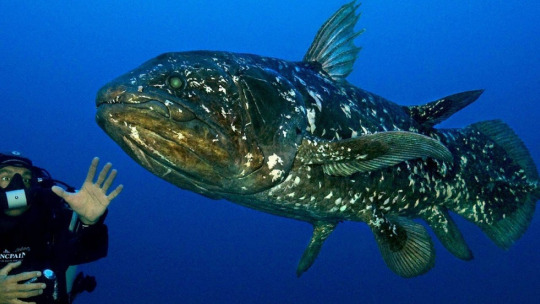
(image: a coelacanth swimming next to a SCUBA diver)
Because of the rarity of coelacanths, it's hard to figure out what conservation needs they have. The IUCN currently classifies the west Indian ocean coelacanth as critically endangered (with an estimated population of less than 500) and the Indonesian coelacanth as vulnerable. Their main threat is bycatch, when they are caught in nets intended for other species. They aren't fished commercially as their meat is very unappetizing, but getting caught in nets is still very dangerous and their slow reproduction and maturation means that it is long and difficult to replace population losses. There is an international organization, the Coelacanth Conservation Council, dedicated to coelacanth conservation and preservation.
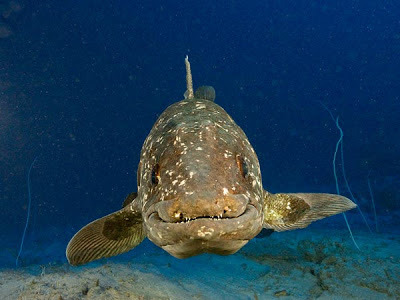
(image: a coelacanth facing the camera. The shape of its mouth makes it look as though it is smiling)
#wet beast wednesday#coelacanth#marine biology#biology#zoology#ecology#animal facts#fish#fishblr#old man fish#lobe-finned fish#sarcopterygii
1K notes
·
View notes
Note
for a work teambuildy thing i'm making a presentation on interesting and surprising phylogenetic relationships, where species that don't seem closely related are, and vice versa. i've got some bird examples, but do any come to mind among herps?
Ok so I don't know how interesting you will find this, but...
There is the Purple Frog (a rather large and unique looking frog) from India, in the Western Ghats, that was described in 2003. You would think that its closest relative would also be from India, but it actually doesn't have any close relatives in India or other parts of Asia.
Its closest relatives are in the family Sooglossidae, found in the Seychelles (In the Indian Ocean off the East Coast of Africa). The Seychelles split from India during the Late Cretaceous period, before India collided into Asia.
They don't really look that much alike...
The closest relatives to these families are in Madagascar, which split from the Indian subcontinent ~ 88 mya.

Purple Frog (Nasikabatrachus sahyadrensis), family Nasikabatrachidae, endemic to the Western Ghats of India
Adult frog described in 2003, though the juvenile frog was described in 1917. (Though, of course, the adult frog was known by local people).
This frog spends most of its life underground, and emerges to mate during monsoon rains.
Unlike many burrowing frogs, which emerge to feed above ground, this species feeds on termites underground (as well as feeding above).
photograph by P. S. Sivaprasad

Gardiner's Seychelles Frog (Sechellophryne gardineri), family Sooglossidae, Mahé, Seychelles Islands
photograph by Evan Pickett
*This family was once believed to be more closely related to one or more families of frogs found on the African mainland, but subsequent genetic analysis has shown otherwise.
#frog#amphibian#herpetology#animals#nature#india#seychelles#africa#madagascar#sooglossidae#seychelles frog#sechellophryne
123 notes
·
View notes
Text
My most important sapphic ships post before Pride Month ends
What the title says, studying kept (and still keeps me) busy so we gotta go fast lol
Bumbleby (RWBY)

to the surprise of absolutely no one, they get first place (despite me not going in a particular order) because of reasons. They're perfect. Soulmates. Slowburn of all time. Yin and Yang. Eyes the color of each other's souls. Truest OTP to ever OTP in my book. ∞/10
Konosetsu (Negima!)
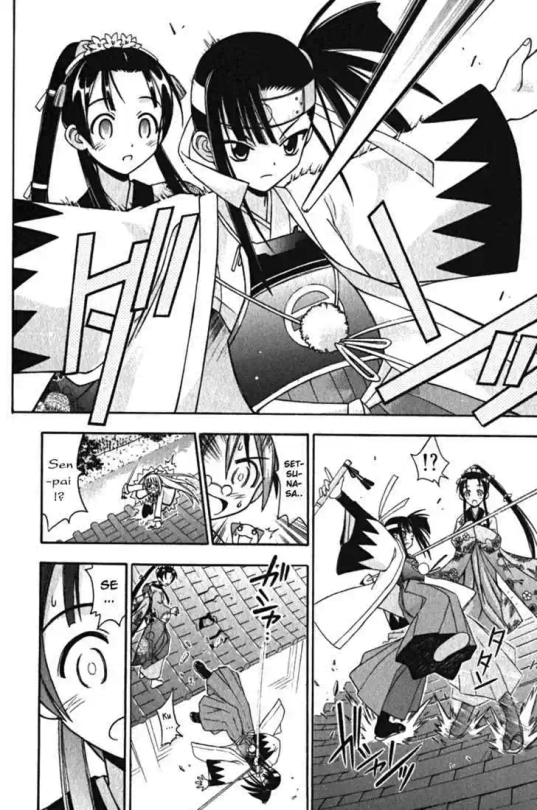
I already talked about them in their own post, this scene changed my life leading to my self-discovery and it still lives rent-free in my mind.
Kyosaya (Madoka Magica)
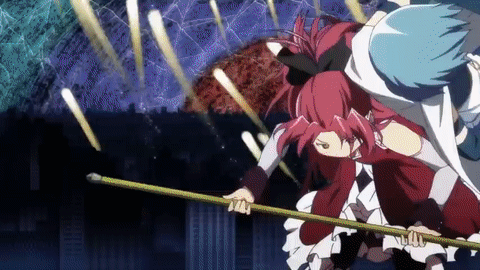
I'd also add MadoHomu but I'm trying to keep it to just one for each fandom. That said, they still make me mentally unwell. I love them, and I did for a long time now. I can't wait for the next movie to come out and suffer.
Ruby and Sapphire (Steven Universe)

These bitches had the first cartoon gay wedding and kiss DO I NEED TO SAY MORE???
Korrsami (Avatar)
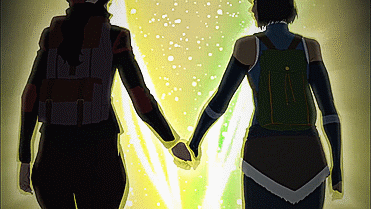
Still down the queer cartoons making history path, these two made me insane back in the day because I still didn't understand I was queer and lots of sapphic couple were starting to appear in media, and I remember jokingly say how "lesbian ships were hauting me". All I can say now is "Thank you" lol. Anyway, they were incredibly important and all the people criticizing how little queerness there's in the show will never understand just how massive this scene was.
Catradora (She-Ra and the Princesses of Power)

Friends to Enemies to back to Friends to Lovers. Iconic. I still want a movie with their adventures bringing magic back to the universe.
Hollstein (Carmilla)

My third beloved blonde with a cat gf ship. I miss this web-series every day. Also, Natasha Negovanlis played an immense role in my gay awakening.
Ellie and Riley (The Last of Us: Left Behind)
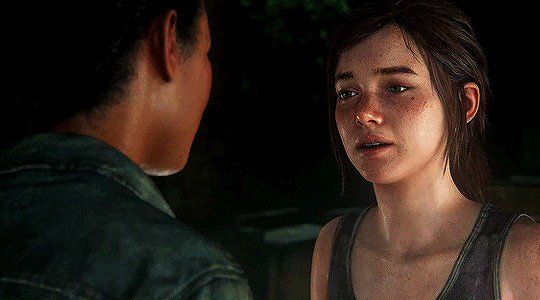
Ellie and Dina are adorable and I love them, BUT I just will never get over these two. That dlc fucked me up. (also, they're in the same category with Korrasami as "gay ships that hauted me before I realized I was queer" lol)
Lumity (The Owl House)

I remember starting this show feeling it as the successor of Steven Universe, at least to me. We could say that at level of mistreatment from its parent company, it defenitely surpassed it, but at least I'm glad I was right and we got Luz and Amity becoming canon. I love these two and not a day passes without me yelling at Disney for what it did to them.
Bubbline (Adventure Time)

I actually watched Adventure Time fully only recently, but I always loved them even when I watched the show randomly when it appeared in tv back in the day. Getting to see the progression properly just made me love them even more.
Yasammy (Jurassic World: Camp Cretaceous/Chaos Theory)
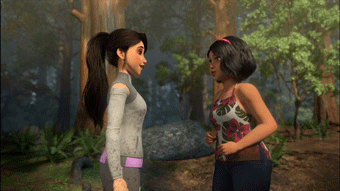
Incredibly recent addition, but I am so glad that I checked out Camp Cretaceous and got into it. It's a nice show and these two are a really cute couple, their confession and especially Yaz's internal turmoil were just so on point. I was really happy to see them go still strong in Chaos Theory, and I can't wait for next season.
Pricefield (Life is Strange)

These two caused me pain in the best possible way. I felt literal heartbreak at the Bay Ending, and I was just as emotional at the Bae one (Bae > Bay Forever) I hope the new game will respect their relationship OR ELSE.
Wow, this is quite the list. I do have an amazing taste, if I do say so myself, ahah!
Well, I guess this is it for now, glad I could make it before Pride Month was over! Knowing myself I might have actually forgotten some though, so keep an eye out for possible updates (what makes me even think that you'd care? lol).
That would be all, be gay and do crimes! Bye!
#rwby#bumbleby#mahou sensei negima#konosetsu#madoka magica#kyosaya#steven universe#rupphire#avatar the legend of korra#korrasami#she ra and the princesses of power#catradora#carmilla series#hollstein#the last of us#rellie#the owl house#lumity#adventure time#bubbline#jurassic world camp cretaceous#yasammy#life is strange#pricefield#happy pride 🌈
203 notes
·
View notes
Text
Round 1 - Phylum Tardigrada
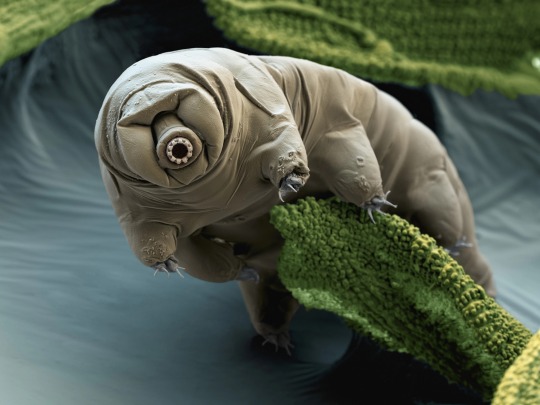



(Source - 1, 2, 3, 4)
The phylum Tardigrada comprises eight-legged, segmented, microscopic animals commonly known as Water Bears or Moss Piglets.
Tardigrades have been found in many different ecosystems, from mountaintops to the deep sea to the Antarctic. They are known for their extreme resilience, being able to survive extreme temperatures and pressures, air deprivation, radiation, dehydration, starvation, and even exposure to outer space. However, they prefer to just live in mosses, lichens, and sediments, munching away on plant cells, algae, bacteria, or small invertebrates (including smaller tardigrade species; that’s not cannibalism btw, plenty of chordates eat other chordate species!) They are not considered extremophiles though, as they are not adapted to exploit extreme environments, only to endure them. They do this by going dormant in harsh environments, for up to 30 years, only to rehydrate and continue living when conditions are safer!
Tardigrades are usually about 0.5 mm long when fully grown, with the largest species reaching up to 1.5 mm. They are short and plump, with barrel-shaped bodies and eight legs, each ending in claws or suction disks. Their backwards-facing hind legs allow them to move in reverse when needed. Like arthropods, they have a cuticle exoskeleton which needs to be molted as the animal grows. They feed using a pair of stylets within their tubular mouth, which they use to pierce their food and suck out the contents. These stylets are lost when the tardigrade molts, so they must secrete a new pair each molt. Some species only defecate when they molt, leaving behind both feces and a shed exoskeleton. They have a large brain for their size, and sense the world via sensory bristles, and some species also have pigment-cup eyes. There are both males and females, with females being larger and more common. Males will gather around a female to court her. Most species have external fertilization, with eggs being laid within a shed cuticle by the female and then fertilized by the male. They can live from several months up to two years, depending on species.
There are two main groups of tardigrades, the Eutardigrades which are the more chubby, suction-cup-fingered ones and the Heterotardigrades, which are the armoured, clawed ones. The oldest known modern tardigrades have been found in Cretaceous amber, but their phylum likely emerged in the Cambrian.

Propaganda under the cut:
I mean… they’re freakin tardigrades. They’re cute. They look like mini Catbusses. This is probably the only microscopic animal for which this many plush toys exist.
“Tardigrada” means “slow steppers”
One species, Echiniscoides wyethi, lives on barnacles.
Tardigrades are relatively common and easy to see with a microscope, making them good subjects for budding microbiologists to study. They can also be kept as pets on a piece of moss, regularly checked via microscope.
They don’t actually like all the extreme environment stuff. Stop putting them in space. Let them chill.
#animal polls#round 1#this is the LAST fully microscopic phylum#we are getting to the Big Boys now#tardigrada
116 notes
·
View notes
Text
Geology and The Terror
As a geologist who is incapable of turning off their geology brain even while watching shows for fun, one of the things that baffles me a bit about The Terror is why they continuously refer to the landscape as shale when both King William Island and the filming location in Pag, Croatia are dominated by limestone. Given the desolation of the landscape, the geology is rather at the forefront of many scenes so it was fun to try and parse it out as I watched.
King William Island, Nunavut, Canada
According to the official map of the bedrock of the region as published by the Canadian government (Harrison et al., 2015), the entirety of King William Island is mapped as dolostone, dolomitic limestone, and limestone with only minor components of shale, sandstone, conglomerate, and breccia. This is a shelf marine deposit dating back to the Late Cambrian, so this is very old sedimentary rock but younger than most of the surrounding hard rock that composes various parts of the Canadian shield. Notably, the pink units mapped on the Boothia Peninsula are Paleoproterozoic in age (2.5-1.6 billion years old), potentially up to 2 billion years older than the limestones of King William Island.

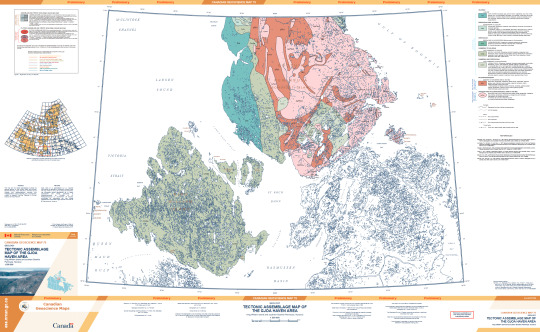
(This is an absolutely massive .pdf file with some scaled features so I would recommend viewing via the official publication to actually read anything or see fine details: publications.gc.ca/pub?id=9.557274&sl=0)
Notably, this map was published in 2015, 8 years after the novel was written. However, according to the bibliography for the map (which can be accessed via the previous link) a preliminary geologic map has existed for the area since at least 1967, though I was unable to track this publication down online. The novel was clearly thoroughly researched and Dan Simmons could have easily accessed this publication and others through multiple institutions.
The surficial geology of King William Island has also been mapped, and is predominantly glacial, as one would expect given it's location. For those unfamiliar with glacial geology processes, this is basically saying that the bedrock is buried under a bunch of glacial deposits. Glacial till is composed of rocks and sediments plucked from the bedrock and ground up. This is why the surface of the island is not one big rock, but a bunch of smaller pieces. Interestingly, the material on the southern part of the island is sandier because it contains more material derived from the Canadian Shield further south. If you're interested in glacial geology, I highly recommend zooming around a bit on Google Earth because the features here are GORGEOUS.
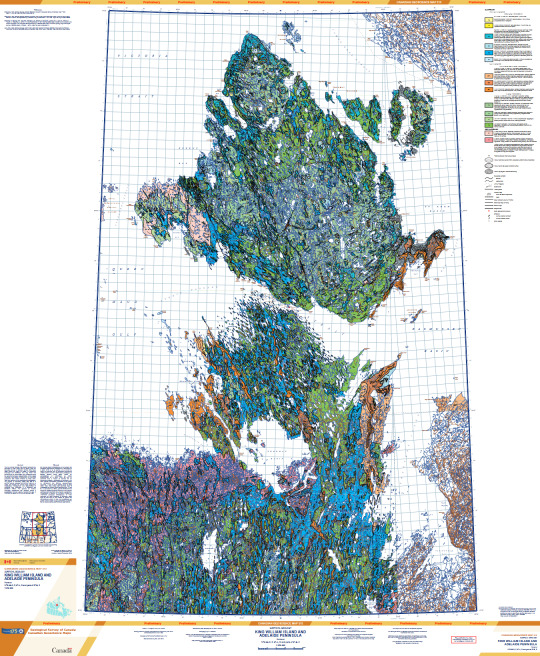
(This map is absolutely massive and the lines scale with zoom so it's hard to see at this resolution, access it here: publications.gc.ca/pub?id=9.834073&sl=0)
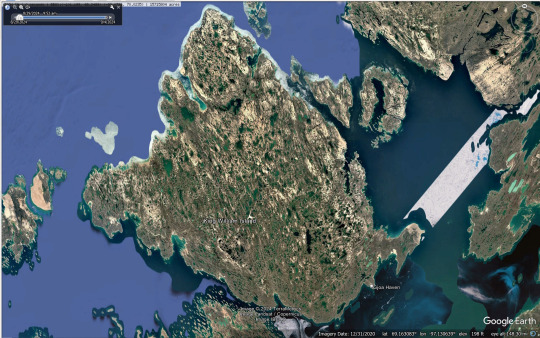
(Google Earth Pro, satellite imagery from 2020)
According to the surface geology map and Google Earth, the actual landscape of King William Island is much more water logged than it appears in the show. It's not entirely impossible that there has been some geomorphological change since 1848, but most of the features mapped would have been formed during the last ice age and as the glaciers melted and not more recently. This would have been handy for the men of the Franklin Expedition because each of these pools is filled with freshwater.
Pag, Croatia
Tracking down a geologic map of Croatia was somewhat challenging as I don't speak Croatian. I was able to find a map of the whole country, and while it's all in Croatian the symbol for the geologic time periods is universal so time periods can be correlated. This shows that the units that make up Pag are Cretaceous and Paleocene-Eocene in age.

(Map accessed here: https://www.hgi-cgs.hr/en/geoloska-karta-republike-hrvatske-1300-000/)
I was able to find a .pdf (access here: http://kig.kartografija.hr/index.php/kig/article/view/158/274) that had a bit more information on the map above but at a lower resolution. This states that the Cretaceous units are dominantly carbonates from the Adriatic sea and the Eocene units are also carbonates. This makes sense as both the Cretaceous and Paleocene-Eocene boundary/PETM are times of increased global temperature correlated with increases in global sea level.
As always, the best geology website out there, Macrostrat, also came through on the unit lithologies. I was unable to access the source listed on Macrostrat, but both the Cretaceous (green) and Paleocene-Eocene units (orange) are listed as limestone.
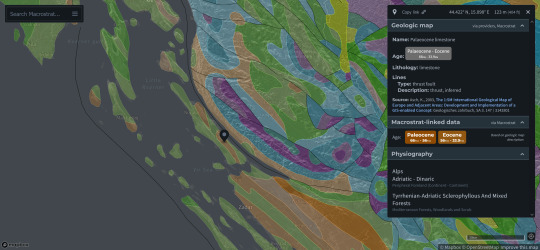
(Source: https://macrostrat.org/map/#x=16&y=23&z=2)
One of the best views that we get of the geology on Pag is the last scene with Bridgens in episode 9. During the zoom out of this scene we get a really nice view of the bedrock and debris covering it.
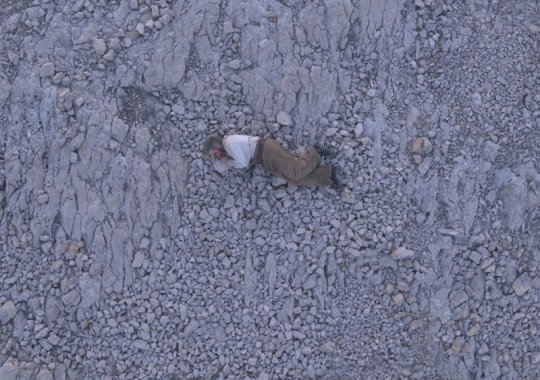
Given all of this, I'm really not sure where the landscape description as shale came from. If there is historical precedence for calling the rocks on the island shale, let me know! I have read a few books but none of the primary sources from the expeditions to this region, so if it comes from that I wouldn't be surprised.
Overall though, I have to say that the filming location was well chosen given the similarities it holds to the geology of King William Island.
#the terror#i have no idea whether this is of interest to anybody else#but i haven't been able to stop thinking about it since i started the show#because obviously the first thing i did was open up macrostrat to see what the geology was like#geology#peter posts#fr though the scene with bridgens is top tier in terms of getting a good view of the geology#it only took me three watches of the show to cave and make a post about it#franklin expedition
135 notes
·
View notes
Text
'Saying Dinosaur Names Is No Joke.’ I Would Love Saying Atrociraptor Over And Over, But Jurassic World's Dichen Lachman Admits It Takes Some 'Homework'
Life has found a way to keep dinosaur fans happy on the 2025 TV schedule, thanks to Jurassic World: Chaos Theory Season 3! A new round of adventures has brought the Camp Fam from Camp Cretaceous even deeper into the web of intrigue connecting to Jurassic World Dominion.
The return of Dichen Lachman’s Soyona “The Broker” Santos continues to blur that line, reintroducing us all to a world where Atrociraptors still roam the earth. As we chatted about her character's Jurassic Park Universe with commanding Atrociraptors, Ms. Lachman told CinemaBlend about this very real challenge with these prehistoric beasts:
"…by the way, saying dinosaur names is no joke. It's like trying to read Greek mythology and pronounce the names correctly. It's so complicated, and I do remember being in the booth, and having to give some of them a go, and then another go, and another go. … Other than Atrociraptors, it was most of them."
While I think I’d have fun saying names like “Atrociraptor” or “Ankylosaurus” on a recurring basis, I can still identify with Dichen Lachman’s Jurassic World: Chaos Theory woe. Even thinking of trying to pronounce “Baryonyx” or “Compsognathus” is a hypothetical weakness, so I don’t envy anyone who has this concern.
So when this Severance star laid out an opportunity that was both a welcomed return, and an unfortunate verbal exercise on Season 3 of this Netflix subscription booster, I could totally see her point. Though I have to say, after discussing this very real problem, I think we should all take a moment and appreciate the various hybrids made by Dr. Wu and his lab assistants never had names as complicated as those of academia.
While Chaos Theory understands Jurassic Park’s legacy as a beloved science fiction classic, it does allow for a bit of a breather from the Latin-intensive names that go beyond entry level difficulty. After all, they can't all have names that end in "Rex."
However, as Dichen Lachman continued to discuss why she’s particularly concerned with the matter, I was even more impressed with her Chaos Theory performance. Continuing to discuss the issue that prehistoric creatures and their names present in a recording booth, Lachman opened up to CinemaBlend with this further insight:
"I'm actually quite dyslexic, and so I'm very insecure about reading words that aren't very familiar to me. It never inhibits my acting, especially 'cause I do my homework, but sometimes with these words in a show like this, I have to be told exactly how it's said."
Admitting that “Google can only take you so far” is a lot for anyone in a career path that requires you to be able to say things properly. There have been times where even after asking for how to pronounce the name of the talent I’m interviewing I might still trip over the pronunciation.
So why would an actor willingly put themselves through the aural equivalent of wrangling an ornery Allosaurus? That question can be answered by referencing another identifiable aspect of this Jurassic World experience, shared by Dichen Lachman as follows:
"But it was tremendously fun to record this character and spend so much more time with her, because as you know, in the film she's not central, in terms of the plot and what's happening. But I didn't get a lot of time to live in her. This opportunity has been so wonderful, because I love that character and I love her energy, and to be given that gift has just been really rewarding."
As Jurassic World Rebirth brings us further into the future, and we know that Dichen Lachman’s Broker survives Dominion and Chaos Theory's events, there’s always room for her to pop up again in the future. And as she mentioned in another portion of our interview, that’s a rumor she’d love to get started sooner rather than later.
Alas, we don’t know if Soyona Santos will be mentioned on Rebirth’s July 2nd opening weekend. However, you can watch her do what she does best in Seasons 2 and 3 of Jurassic World: Chaos Theory - both of which are currently streaming on Netflix. Or, if you're still reeling over Dichen Lachman's Severance Season 2 finale feelings, you know where to find that world of danger and deceit.
25 notes
·
View notes
Text
I’ve recently become interested in legends of avantrist, but the problem is I work with alligators and am very familiar with them and what they look like so every single Kremy art I see I’m like, “you’re no alligator you fuckin imposter…”
For anyone interested, here’s some miscellaneous alligator facts
Alligators have five toes on their front limbs and four toes on their hind limbs. Only the first three toes on each foot has claws.

Despite common media depictions, alligators are NOT green. They are black, dark grey, dark brown, and in VERY rare occasions, white or yellow, though these ones only survive in captivity. This is actually one of the ways to distinguish them from crocodiles, because crocs are much lighter in color, being a brownish green, tan, or a lighter grey. Alligators also loose their juvenile stripes at around 3-4 years old, while most crocodiles keep them their whole lives.


Alligators have thousands of tiny black dots on their face that kinda resemble a five o’clock shadow. No, it’s not facial hair or blackheads, they’re actually integumentary sensory organs that sense movement in the water around them and make their faces extreamly sensitive to touch.

Alligators do have ears, they’re just a little hard to notice. It’s the slit behind the eye.

Alligators have no sense of personal space. They will crawl all over each other trying to get the best sunning spot. It’s like they see other alligators as big rocks that sometimes move. (At work, we call them cuddle piles)


Despite how similar they look, alligators and crocodiles are not closely related. They diverged from one another around 100 to 90 million years ago during the late Cretaceous period. For reference, the last common ancestor of all big cats lived 10 million years ago.
Alligators have tongues, but they are attached and can’t move like ours.
Mama alligators are very protective of their babies and protect them for a year after they hatch before ditching them.
Alligators grow about 6 inches a year until they reach maturity at 10 to 12 years old. By this point the gator is about 6 feet long and will continue to grow through its entire life, though at a much slower rate.
Alligators are cannibalistic and won’t hesitate to eat a smaller alligator.
How do you tell the difference between a male and female alligator? Just put your finger in its cloaca. If something pokes you, it’s a male.
Alligators and all other crocodilians are more closely related to birds than any other member of the class reptilia. If birds aren’t reptiles, then neither are crocodilians.
33 notes
·
View notes
Text
It's worth doing a full analysis on how the Jurassic Park franchise makes the "bad man-eating carnivore, nice and friendly herbivore" dichotomy so prevalent it's almost a staple of its writing now. In Jurassic World, the pteranodons get released and they attack humans for no other reason that, well, this is a monster movie and they have to. In Camp Cretaceous, there's a carnotaurus that stalks and wants to kill the kids for no other reason than well, this is a monster series and they have to have a monster, but they approach and make friends with a Pachyrhinosaurus because it's an herbivore and herbivores are nice. Now, I can't say for sure what was the exact behavior of a Pachyrhinosaurus, but based on our current large horned herbivores, I have a feeling approaching one would be as a good idea as a stranger approaching a bull or a rhinoceros.
These are the examples I can recall now, that's why I said it would be great to do a full analysis, but it all comes down to the fact that in the writing herbivore = good and carnivore = bad. In real life, and thus we can assume that for dinosaurs, large herbivores are extremely territorial and aggressive, always on the look out for any potential threat. A human just happens to be around the size of a random dromeosaur and bipedal too, if a dinosaur saw or heard a bunch of humans approaching it, it would be in alarm mode instantly. Big sauropods might not care out of sheer size, but I don't think it would be safe to approach a 30 meter long animal either. Meanwhile, carnivores would not be safer, either, but most apex predators tend to spend the time between hunt resting and trying to conserve energy, lazying around.
I mean, I'm being generic here since there are lots of kinds of animal behavior but it's never "good nice herbivores". In fact, the nice herbivores we know are because of domestication, because wild goats/sheep and horses are incredibly aggressive, and I'm still not sure how we domesticated aurochs or fucking boars.
But that's because Jurassic Park isn't as much as interested in showing an ecosystem or actual behavior, but rather, the dinosaurs are characters too in a movie, and you have good and bad characters. Which is fine, I mean, it's not a documentary, is it? But many people do treat it as such, in the sense of what they see there is what the popular conception of dinosaurs are, and even the conception of how animals and ecosystems 'work' in the first place. I'm not blaming Jurassic Park for seeing all those people commenting "why didn't you rescue it???" in videos of a wild animal predating another, but I do think it's a kind of thinking (moralizing animals) that comes from that viewpoint.
101 notes
·
View notes
Note
Opinions on Carnotaurus, they've always been one of my favorite dinosaurs and its very funny seeing people deny feathers on dinosaurs from the perspect of having the one dinosaur where most evidence (as far as i know, might need to catch up on some reading) points to no feathers. Its a real spiders georg situation
like carnotaurus has amazing skin impressions and no signs of feathers, which is fine! We know lots of dinosaurs probably lost their feathers at big sizes! but we still don't really know that a scaley fossil indicates no feathers. We need more taphonomic data on that, and such studies are hard to come by.
Anyways, feathers, no feathers, whatever. The most interesting thing about Carnotaurus is that its a sosig (sausage).

(by Andrey Atuchin, CC BY SA 4.0)
Abelisaurs were cursorial acrobats. They could turn on a dime and their long, ovular bodies helped with that, as well as their muscular legs and tail. Their heads were attached to strong necks, so they could just attack prey with their mouths while moving fast.
This was important, because most Abelisaurs in the late cretaceous were the top predators of their ecosystems, and what lived in their ecosystems?
Giant fucking titanosaurs
So being able to turn and move quickly gave these guys a leg up on the slower-moving giant bird giraffe-elephants around them
they didn't need their arms for hunting or movement anymore, so that's why they're so small - muscles in the neck region of dinosaurs tend to occupy a similar space as the muscles in the arm region, so more of one leads to a loss in the other. Strong neck for strong bites = weaker arms.
That said, what's weird is that they have a fully 360 degree rotational arms, which is not actually common, so it doesn't seem like something arms that aren't being used would have. Perhaps these tiny little nubbins were used for display - with bright colors or the like - and rotated around in the socket. Dinosaurs are very much Display oriented animals, as we see in living birds and the variety of display structures in extinct forms. this may just be the weirdest take on that theme!
Plus, the horns are Spiffy
346 notes
·
View notes
Text
Crystal Palace Field Trip Part 2: Walking With Victorian Dinosaurs
[Previously: the Permian and the Triassic]
The next part of the Crystal Palace Dinosaur trail depicts the Jurassic and Cretaceous periods. Most of the featured animals here are actually marine reptiles, but a few dinosaur species do make an appearance towards the end of this section.
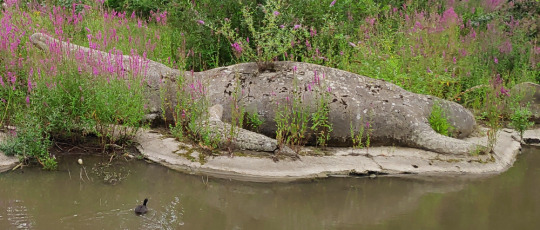
Although there are supposed to be three Jurassic ichthyosaur statues here, only the big Temnodontosaurus platyodon could really be seen at the time of my visit. The two smaller Ichthyosaurus communis and Leptonectes tenuirostris were almost entirely hidden by the dense plant growth on the island.

Ichthyosaurs when fully visible vs currently obscured Left side image by Nick Richards (CC BY SA 2.0)
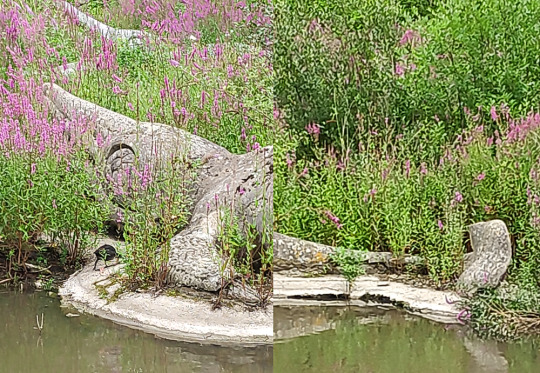
Head, flipper, and tail details of the Temnodontosaurus. A second ichthyosaur is just barely visible in the background.
Ichthyosaurs were already known from some very complete and well-preserved fossils in the 1850s, so a lot of the anatomy here still holds up fairly well even 170 years later. They even have an attempt at a tail fin despite no impressions of such a structure having been discovered yet! Some details are still noticeably wrong compared to modern knowledge, though, such as the unusual amount of shrinkwrapping on the sclerotic rings of the eyes and the bones of the flippers.

———

Arranged around the ichthyosaur, three different Jurassic plesiosaurs are also represented – “Plesiosaurus” macrocephalus with the especially sinuous neck on the left, Plesiosaurus dolichodeirus in the middle, and Thalassiodracon hawkinsi on the right.
They're all depicted here as amphibious and rather seal-like, hauling out onto the shore in the same manner as the ichthyosaurs. While good efforts for the time, we now know these animals were actually fully aquatic, that they had a lot more soft tissue bulking out their bodies, and that their necks were much less flexible.

———
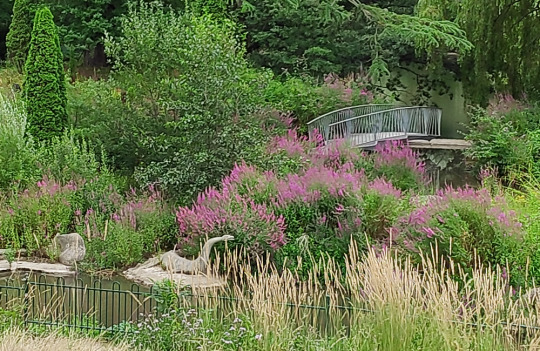
The recently-installed new pivot bridge is also visible here behind some of the marine reptiles.
———
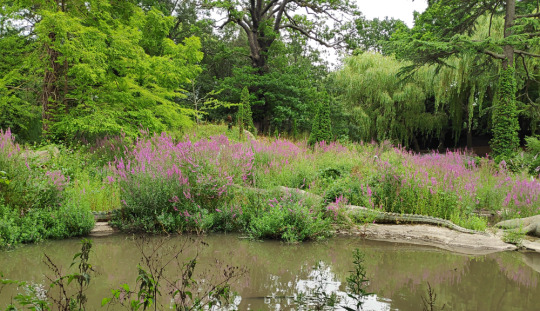
Positioned to the left of the other marine reptiles, this partly-obscured pair of croc-like animals are teleosaurs (Teleosaurus cadomensis), a group of Jurassic semi-aquatic marine crocodylomorphs.

A better view of the two teleosaurs by MrsEllacott (CC BY-SA 4.0)
The Crystal Palace statues have the general proportions right, with long thin gharial-like snouts and fairly small limbs. But some things like the shape of the back of the head and the pattern of armored scutes are wrong, which is odd considering that those details were already well-known in the 1850s.

———
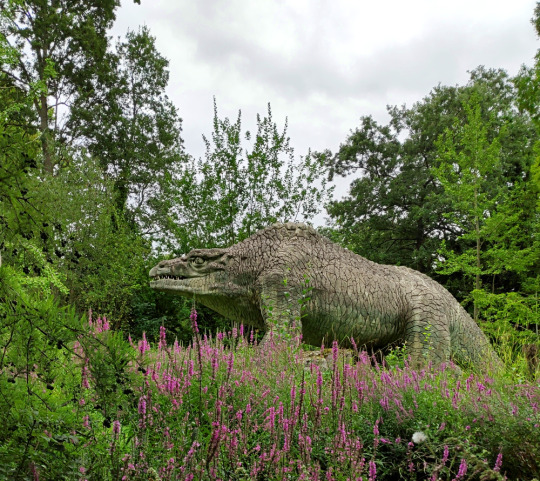
Finally we reach the first actual dinosaur, and one of the most iconic statues in the park: the Jurassic Megalosaurus!
Megalosaurus bucklandi was the very first non-avian dinosaur known to science, discovered in the 1820s almost twenty years before the term "dinosaur" was even coined.
At a time when only fragments of the full skeleton were known, and before any evidence of bipedalism had been found, the Crystal Palace rendition of Megalosaurus is a bulky quadrupedal reptile with a humped back and upright bear-like limbs. It's a surprisingly progressive interpretation for the period, giving the impression of an active mammal-like predator.
This statue suffered extensive damage to its snout in 2020, which was repaired a year later with a fiberglass "prosthesis".

———
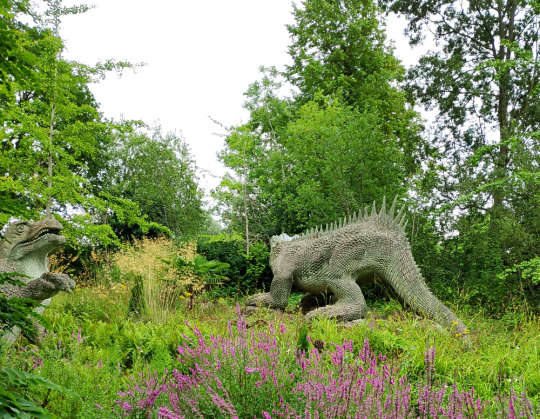
Reaching the Cretaceous period now, we find Hylaeosaurus (and one of the upcoming Iguanodon peeking in from the side).
Hylaeosaurus armatus was the first known ankylosaur, although much like the other dinosaurs here its life appearance was very poorly understood in the early days of paleontology. Considering how weird ankylosaurs would later turn out to be, the Crystal Palace depiction is a pretty good guess, showing a large heavy iguana-like quadruped with hoof-like claws and armored spiky scaly skin.
It's positioned facing away from viewers, so its face isn't very visible – but due to the head needing to be replaced with a fiberglass replica some years ago, the original can now be seen (and touched!) up close near the start of the trail.


———

Two pterosaurs (or "pterodactyles" according to the park signs) were also supposed to be just beyond the Hylaeosaurus, but plant growth had completely blocked any view of them.
Although these two statues are supposed to represent a Cretaceous species now known as Cimoliopterus cuvieri, they were probably actually modeled based on the much better known Jurassic-aged Pterodactylus antiquus.
A second set of pterosaur sculptures once stood near the teleosaurs, also based on Pterodactylus but supposed to represent a Jurassic species now known as Dolicorhamphus bucklandii. These statues went missing in the 1930s, and were eventually replaced with new fiberglass replicas in the early 2000s… only to be destroyed by vandalism just a few years later.
(The surviving pair near the Hylaeosaurus are apparently in a bit of disrepair these days, too, with the right one currently missing most of its jaws.)
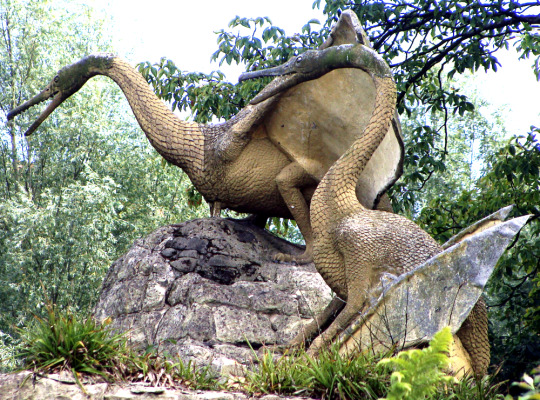
Image by Ben Sutherland (CC BY 2.0)
The Crystal Palace pterosaurs weren't especially accurate even for the time, with heads much too small, swan-like necks, and bird-like wings that don't attach the membranes to the hindlimbs. Hair-like fuzz had been observed in pterosaur fossils in the 1830s, but these depictions are covered in large overlapping diamond-shaped scales due to Richard Owen's opinion that they should be scaly because they were reptiles.
But some details still hold up – the individual with folded wings is in a quadrupedal pose quite similar to modern interpretations, and the bird-like features give an overall impression of something more active and alert than the later barely-able-to-fly sluggish reptilian pterosaur depictions that would become common by the mid-20th century.

(Much like the statues themselves, the "modern" reconstruction above is based on Pterodactylus rather than Cimoliopterus)
———
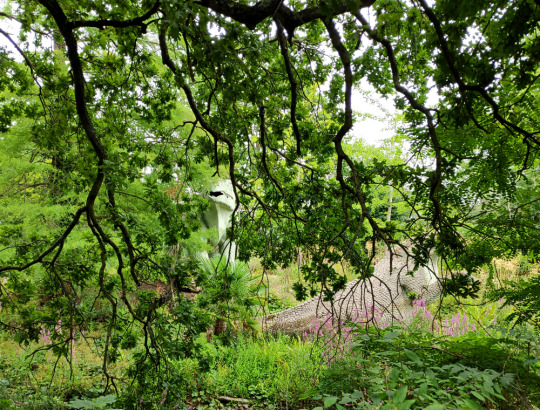
The last actual dinosaurs on this dinosaur trail are the two Cretaceous Iguanodon sculptures. At the time of my visit they weren't easy to make out behind the overgrown trees, and only the back end of the standing individual was clearly visible.
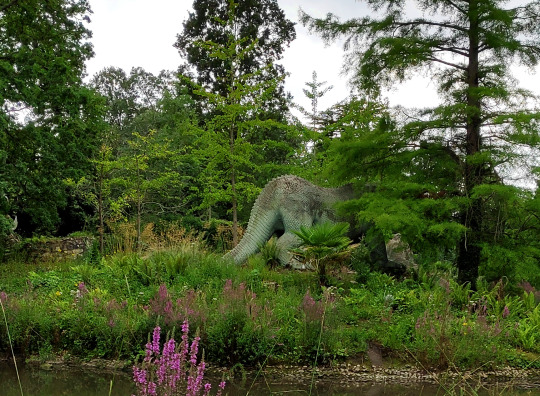
Named only a year after Megalosaurus, Iguanodon was the second dinosaur ever discovered, and early reconstructions depicted it as a giant iguana-like lizard.
The Crystal Palace statues depict large bulky animals, one in an upright mammal-like stance and another reclining with one hand raised up. (This hand is usually resting on a cycad trunk, but that element appeared to be either missing or fallen over when I was there.)
Famously a New Year's dinner party was held in the body of the standing Iguanodon during its construction, although the accounts of how many people could actually fit inside it at once are probably slightly exaggerated.
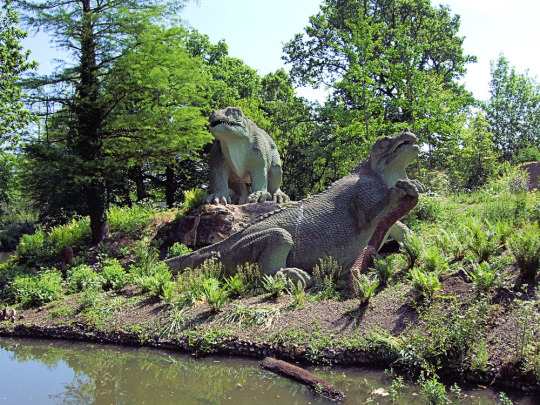
A clearer view by Jim Linwood (CC BY 2.0)
Considering that the skull of Iguanodon wasn't actually known at the time of these sculpture's creation, the head shape with a beak at the front of the jaws is actually an excellent guess. The only major issue was the nose horn, which was an understandable mistake when something as strange as a giant thumb spike had never been seen in any known animal before.

(The fossils the Crystal Palace statues are based on are actually now classified as Mantellisaurus atherfieldensis, but the "modern" reconstruction above depicts the chunkier Iguanodon bernissartensis.)
———
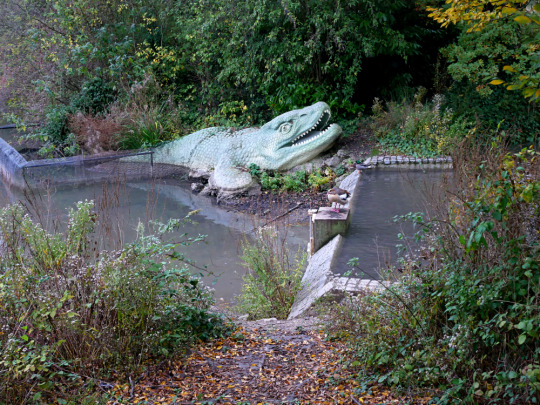
Image by Doyle of London (CC BY-SA 4.0)
I also wasn't able to spot the Cretaceous mosasaur on the other side of the island due to heavy foliage obscuring the view.
Depicting Mosasaurus hoffmannii, this model consists of only the front half of the animal lurking at the water's edge. It's unclear whether this partial reconstruction is due to uncertainty about the full appearance, or just a result of money and time running out during its creation.
The head is boxier than modern depictions, and the scales are too large, but the monitor-lizard like features and paddle-shaped flippers are still pretty close to our current understanding of these marine reptiles. It even apparently has the correct palatal teeth!

Next time: the final Cenozoic section!
#field trip!#crystal palace dinosaurs#retrosaurs#i love them your honor#crystal palace park#crystal palace#ichthyosaur#plesiosaur#teleosaurus#crocodylomorpha#marine reptile#megalosaurus#theropod#hylaeosaurus#ankylosaur#iguanodon#ornithopoda#ornithischia#dinosaur#pterodactyle#pterodactylus#pterosaur#mosasaurus#mosasaur#paleontology#vintage paleoart#art
478 notes
·
View notes
Text
Croc Paleontology Recap January 2025
The year has just begun and already we got a bunch of pretty neat new studies on fossil pseudosuchians so I'll just briefly go over them and unless I forget or end up procrastinating/getting too busy I'll hopefully be able to keep this going throughout the rest of the year.
Just to give you a brief overview, the highlights of this month include: salt glands in gavialoids, crocodilian predation on azhdarchids, diversifications and extinctions in thalattosuchians and a new species of aetoaur from India. Lets begin.
Evidence for salt glands in gavialoids
Starting off with something relating to the dispersal of gavialoids, we got "Evaluation of the endocranial anatomy of the early Paleogene north African gavialoid crocodylian Argochampsa krebsi and evolutionary implications for adaptation to salinity tolerance in marine crocodyliforms" by Pliggersdorfer, Burke and Mannion.
The title already gives a lot away, but the point was that Argochampsa, from the early Paleocene Ouled Abdoun Basin in Morocco, was examined for evidence of salt tolerance. Why? Because the dispersal of gavialoids remains weird. Both modern forms aren't especially keen on saltwater and are only known to consistently occur in freshwater (tho we have a recent example of an indian gharial caught in a fishing net off the coast of India), yet we have plenty of extinct gavialoids that either indicate that the group must have crossed oceans (see any "gryposuchine") or straight up lived at sea (also see some "gryposuchines").
Now, one such example might also be Argochampsa. Both because the Ouled Abdoul Basin famously preserves coastal deposits and because, at least following some phylogenies, Argochampsa might be closely related to the gharials of South America and today (others say its not even a gavialoid but lets ignore that for now). So all things considered one might expect marine habits from Argochampsa, yet so far no such adaptations could be identified. Well, Pliggersdorfer and co. analyzed a thus-far undescribed skull and actually managed to find something. Small depressions on the inside of the skull are suspiciously similar to ones seen in the extinct, fully marine metriorhynchoids, depressions that in the latter have been interpreted as having been left by salt glands. There is also some further evidence through the morphology of the inner ear.
This conclusion further extends to a handfull of other taxa, including the dyrosaurid Rhabdognathus and the recently named gavialoid Sutekhsuchus, and lends itself to the hypothesis that salt glands may have been ancestral to gavialoids, something I personally find unsurprising given their proximity to crocodyloids and their dispersal across the world (really if anything alligatoroids seem like the odd one out).
Fun fact, yours truly is featured in the paper in the form of two silhouettes.
Left: Argochampsa, illustrated by Seismic Shrimp/JW Right: Piscogavialis, perhaps the most famous marine gavialoid, illustrated by Joschua Knüppe


The brain of Paralligator
Second on our neat little list, the neuroanatomy of Paralligator, studied through CT scans and 3D modeling and published on in "Neurocranial anatomy of Paralligator (Neosuchia: Paralligatoridae) from the Upper Cretaceous of Mongolia". Given that I am not great with brain things, I'll keep this one short.
Now for those unfamiliar, Paralligator is part of a somewhat strange clade known as the Paralligatoridae, which contrary to their name are nowhere near real alligators (tho some do look deceptively similar). Instead, they are much more basal members of Eusuchia.
Measurements of the olfactory bulbs, responsible for the sense of smell, indicate that in Paralligator this sense was similarily developed to allodaposuchids and crocodilians, as is the inner ear who's anatomy suggests a semi-aquatic lifestyle. Paralligator does however differ in possessing a mesothemoid, a bony septum in the olfactory region that is also seen in dyrosaurids, baurusuchids and dinosaurs, but not modern crocodiles.

Borealosuchus remains from Colorado
Tho seemingly unexciting, this study, "First record of Borealosuchus sternbergii from thelower Paleocene Denver Formation (lower Danian),Colorado (Denver Basin)" actually helps us fill a neat little gap in our previous knowledge on croc survival across the Cretaceous-Paleocene extinction.
Simply put, though America's croc record across the KPG is rather remarkable, showing both many survivors and some incredible diversification after the impact, Colorado is kind of a blind spot, despite its potential importance. Perhaps one of the best examples of a survivor concerns the genus Borealosuchus, which is both geographically and stratigraphically widespread. To put things into perspective, this genus occured as far north as Canada and as far south as Texas, first appearing in the Late Cretaceous and dying out in the Eocene.
This paper now described several skulls from the Corall Bluff's locality of the Denver Formation, earliest Paleocene, that can be attributed to Borealosuchus sternbergii, definitively extending its range beyond KPG (granted, there are tentatively referred Paleocene occurences elsewhere), making it one of the largest suvivors of the mass extinction, with adults growing up to 2.3 meter in length. The specimens from Colorado are smaller, in the 1.5 to 1.7 meter range, but they are also regarded as immature individuals and are therefore also regarded as usefull in illustrating how the animals changed as they grew into adulthood.
This paper is especially well timed for those that follow @knuppitalism-with-ue 's Formation Stream series. As you might know, Corall Bluffs is to be drawn barely a week from now and this is a fantastic addition.
Left: Borealosuchus drawn by Atak_Draws Right: Distribution of Borealosuchus by Lessner, Petermann and Lyson 2025

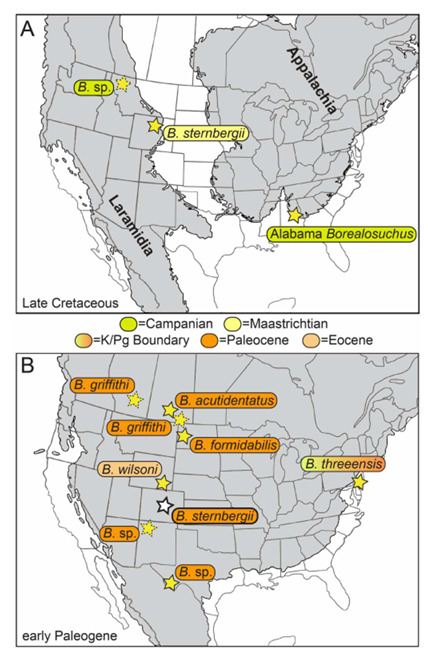
Growth of a peirosaur
Our next paper for discussion is "Life history and growth dynamics of a peirosaurid crocodylomorph (Mesoeucrocodylia; Notosuchia) from the Late Cretaceous of Argentina inferred from its bone histology" by Tamara G. Navarro and colleagues. This study conducted the first histology of peirosaurid limb bones, specifically of an indetermined taxon clading together with Uberabasuchus.
As a brief refresher, peirosaurids are a branch of medium to large sized Notosuchians that I personally think can be aptly described as appearing somewhat like scaly dogs or pigs with often robust, wedge-shaped heads and heavily armored bodies.
The results show that the animal had reached sexual maturity, yet was not yet fully grown. What's also noted is the exact growth dynamics of this animal. This is to say, the studied peirosaurid had overall slow growth with cycles of no growth whatsoever and two periods of increased growth, tho once put against other notosuchians the study deems the growth rates to be better described as "moderate". Pepesuchus meanwhile, belonging to the closely related itasuchids, was a fast grower. Extending things beyond their shared clade shows a virtual mish-mash of dynamics, with Araripesuchus buitreraensis displaying slow growth rates (yet Araripesuchus wegeneri having faster rates than the peirosaur), Iberosuchus showing slow rates, and Notosuchus displaying high growth rates (hell, theres even variation between individuals). A final point concerns the age of the individual, which is....contradictory. Based on the limb bones, the study estimates that the animal was at the very least 15 years old, but previous study of the osteoderms has yielded an estimated age of 18 years old. Ultimately, further study is needed, but it does clearly show how the histology of different parts of the skeleton varies.
Shown below, Uberabasuchus terrificus by Scott Reid

Predation on pterosaurs
Here's a fun one, "A juvenile pterosaur vertebra with putative crocodilian bite from the Campanian of Alberta, Canada", once again with a name that tells you very much what you're in for.
Brown and colleagues report on the discovery of a juvenile specimen of the azhdarchid Cryodrakon from the Dinosaur Park Formation of Alberta, Canada. The neck vertebra bears some conical bite marks, notably different from those of theropods, which generally have D-shaped or compressed tooth crosssections (sans spinosaurids, which aren't present). Champsosaurus is also ruled out due to its inferred feeding preferences, weak bite force and slender teeth. Mammals are potential candidates, but the team regards it as more likely that the trace maker was a crocodilian. Considering the fauna of the Dinosaur Park Formation, this would suggest the culprit was either Leidyosuchus, Albertochampsa or an animal described as "Stangerochampsa-like".
Now this is a very interesting, if not exactly unexpected interaction. On the one hand, having direct fossil evidence for this is a big deal, even if we don't know if the bite marks were left due to the pterosaur being actively hunted or if they were simply left when a lucky croc came across the carcass of an already deceased Cryodrakon. On the other hand, crocodiles and kin are notoriously opportunistic and broad in their diet, so one feeding on a pterosaur is something that seems like a no-brainer in principle, especially a relatively small individual with a wingspan of "only" 2 meters. This is further supported by the fact that crocodilian bite marks have also been reported from the Romanian pterosaur Eurazhdarcho.
Obvious difference in prey size and geography aside (and taxon names even within the chosen setting while we're on it), Prehistoric Planet really nailed the nailon the head with this one.
In the left corner, a juvenile Cryodrakton (art by Hank Sharpe). In the right corner, Leidyosuchus (art by Gunnar Bivens) LET THEM FIGHT (or scavenge)
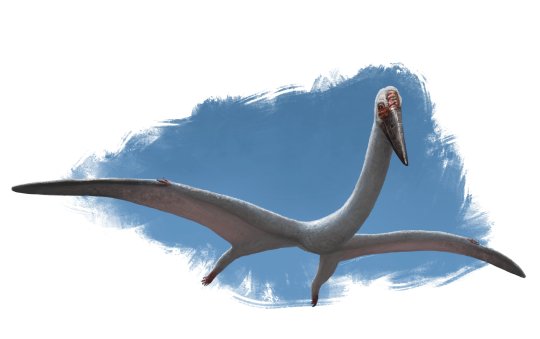
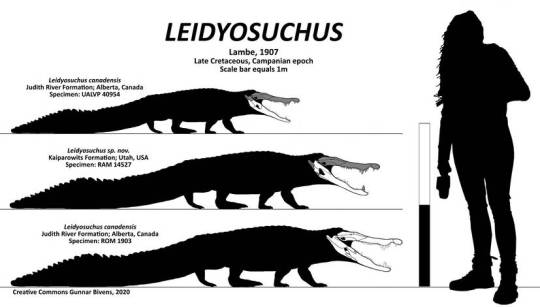
Evolutionary trends and extinctions in Thalattosuchia
This one's a last minute entry, by which I mean this one got just published as I was about to wrap this whole thing up. "Analysing Thalattosuchia palaeobiodiversity through the prism of phylogenetic comparative methods" explores how the evolution and the extinctions of members of this group were shaped by both biotic and abiotic factors.
Given the shere breadth of this topic, a quick summary of thalattosuchia seems kinda in order. In short, thalattosuchians are a group of what are likely to be early crocodyliforms adapted to life at sea. They can be split into two groups, the teleosauroids, superficially gharial like animals that likely stuck to coastal waters, and the metriorhynchoids, open ocean animals with fluked tails, no body armor and paddle-like limbs. Both groups reached their greatest diversity in the late Jurassic, but managed to survive into the Cretaceous before disappearing entirely.
The study recaps that thalattosuchians first reach great diversity during the Toarcian, tho this is likely influenced by preservation bias thanks to Lagerstätten such as the Posidonia shale, and a later diversification takes place during the Bathonian. Regardless, the transition from the lower to middle Jurassic sees an increased trend in both thalattosuchian groups towards shorter snouts, which are associated with durophagy or hypercarnivory. This essentially gives rise to the teleosauroids of the Machimosaurinaei, which appear during the Bathonian and have blunt, robust teeth, as well as the metriorhynchoid Geosaurinae, which appeared at the same time and had ziphodont (serrated teeth). The reasons for this could be twofold. On the one hand, thalattosuchians were very abundant, so expanding into new nisches helped them coexist, with ecosystems preserving fish-eaters, hypercarnivores, durophages and more at the same time. More of an underlying factor could be a drop in ichthyosaur diversity, leaving plenty of open nisches for these crocs to fill.
Subsequently, during the transition from the Middle to Late Jurassic, there was another diversification event with both groups establishing new major clades, possibly associated with the warm temperatures of the Late Jurassic, before the diversity crashes with the onset of the Cretaceous. The authors note that this too might have been related to climate, with the Cretaceous survivors mostly being found in warmer waters.
Left: A Dakosaurus ambushing an ichthyosaur by Gabriel Ugueto Right: A large Machimosaurus rests on the beach as a sauropod approaches, art by Joschua Knüppe


and for the final study I wanna talk about
Kuttysuchus: A new Aetosaur from India
Now, by all accounts one might be surprised to see this just kinda thrown in at the end here rather than getting a dedicated post as I usually like to do with new forms. And truth be told, theres just not that much to say about "A New paratypothoracin aetosaur (Archosauria: Pseudosuchia) from the Upper Triassic Dharmaram Formation of India and its biostratigraphic implications".
Kuttysuchus is our first pseudosuchian to be described this year and to get things out of the way, its not super exciting in terms of material. Like some other recently named aetosaurs, Kuttysuchus is based entirely on a handfull of osteoderms. And there's nothing wrong with that, after all osteoderms are rather distinctive for these animals. It does however mean that the information we can get from them is a bit limited and thus makes it hard to really put together something engaging.
More interesting than the anatomy then is the range and its relationship to other aetosaurs. The fossils are known from the Dharmaram Formation of India, which you might recall is also home to the recently named Venkatasuchus. Both Venkatasuchus and Kuttysuchus are members of the Paratypothoracini, tho the former is significantly more derived and the latter more basal.
Fossil osteoderms of Kuttysuchus, all belonging to the central double row that stretches across the back.
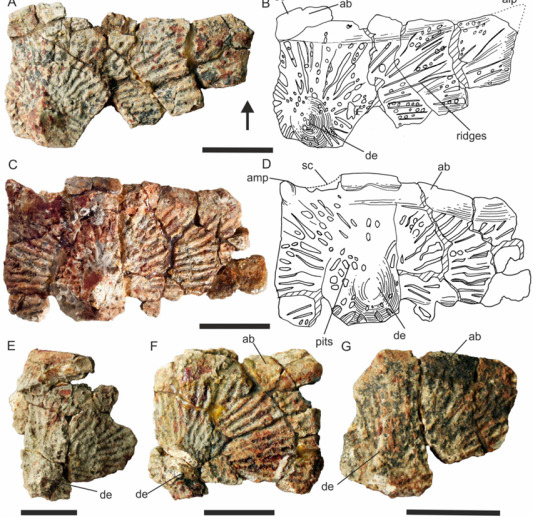
I'll be entirely honest. This was a lot more work to type out than anticipated, but admittedly also fairly rewarding. Hopefully you dear reader found it equally interesting, and hey, congrats on making it to the end.
#palaeoblr#paleontology#prehistory#croc#crocodile#long post#pseudosuchia#sutekhsuchus#argochampsa#peirosauridae#thalattosuchia#metriorhynchoidea#teleosauroidea#kuttysuchus#aetosauria#paralligator#leidyosuchus#cryodrakon#borealosuchus
141 notes
·
View notes
Text
Hey all!! I managed to see the sonic 3 movie a day BEFORE it officially released (THATS RIGHT THE 19TH BABY!!!) and OH BOY WAS IT SOMETHING
IT WAS SO GOOD I WAS FUCKING INSANE THE ENTIRE TIME
I ALSO GOT A LIMITED EDITION POSTER??? READ IT AND WEEP BOYS
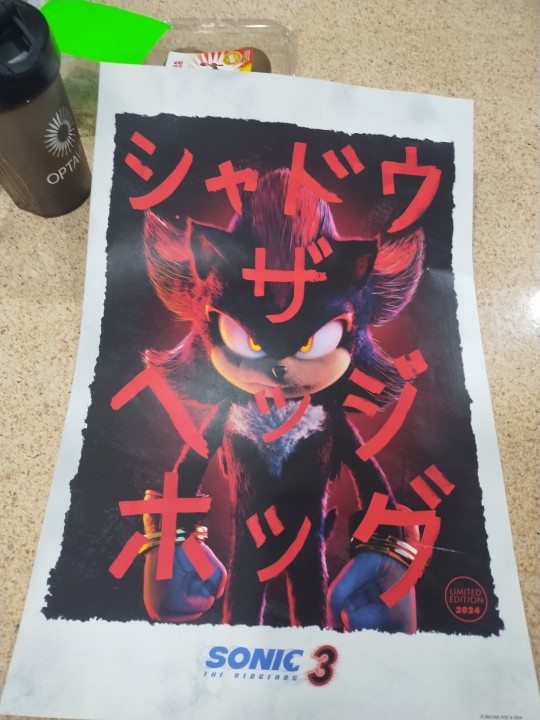
(and here is the promo cutout they had, I wish I could've taken it home 😭)
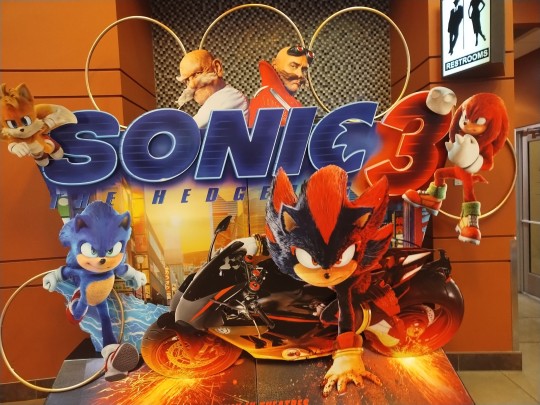
And lemme tell y'all, your fears did not come true!!! There were no fatphonic jokes (that I saw at least) and the gun uniforms were not as they seemed.
I only have one (1) bad thing to say about this movie, which I can't say here, spoilers.
Anyways, I liveblogged (what I could, my fingers could NOT type fast enough) my thoughts in a draft. One of my irls (you know who you are) requested to see my thoughts, so I figured I'd post them
Without further ado,
Sonic 3 spoilers below the cut
"You lost her when you were so young, but you didn't let that pain change you. You stayed the same, in here (points to his heart)"
GUYS IM IM IM!!!!!!!!!!
"we need team sonic" "who chose that name?"
Did they suddenly conscript these children?? Are they that pathetic??? ALSO WHY DIDNT MADDIE OR TOM PUT UP A FIGHT PLEASE GUYS
"talk about a low budget flight, no food or movies? We're outta here" THEY SAID THE THING THE THING THE THING THEY SAID IT
HES GOT A SICKASS ENERGY GUN????
HE DOES THE AKIRA SLIDE UP A SKYSCRAPER?
Also he,,, he has the LIVE AND LEARN THEME EVERYTIME HE DOES SOMETHING COOL
THE RESTAURANT IS CALLED "CHAO GARDEN"
THEY CALLED HIM THE ULTIMATE LIFEFORM!!!!!
DUDE STONE ALSO HAS A SICK ASS MOTORCYCLE???? HIS INTRODUCTION IS HIM DODGING A MISSLE
A WHITE MAN DIED ON SCREEN????? Ohhh this is how they're gonna frame sonic
"please join me in the crab" STONE YOU ARE THE FUNNIEST MAN EVER
"the person I trust most in the world" STONEBOTNIK CONFRIMED????
Bro needs his hedgehog electric shock fix 💀💀
WAS MARIA ON EARTH???
Shadow: >:(
Maria: >:)
BLANKET FORT??? 😭😭😭😭
Gerald: *sees a grieving child* what if I manipulate him into being my weapon
THE MENTION OF KNUCKLES AND GHOSTS!! PUMPKIN HILL!!!
THEYRE SO GAY???? STONEBOTNIK WE ARE WINNING
Also he hasn't gotten another shirt this is fucking wonderful 😭😭
OH MY GOD HES BISEXUAL I DIDNT KNOW THAT
"where'd you go hedgehog, I wasn't done trauma dumping"
"LIKE TWO CHARACTERS IN A MOVIE BEING PLAYED BY THE SAME ACTOR" (looks at fourth wall)
I need someone to check if all the quiz questions are true, please
THEY BOTH NEED THEIR HEDGEHOG SHOCK FIX
Damb, not the kink shaming from eggman
"GOOD ONE HOT TOPIC" IM GOING TO SCREAM
YEAHH THE WRITING IN THE PRISON CELL
YEAHHH ECLIPSE CANNON TIME!!!
"holy crab"
"spacious and cretaceous"
"the crab flies :)"
OH YEAH RESOLVING THE DADDY ISSUES
NOO STONE NOT THE GAY LONGING :(((
"don't be bad parents—" "YEAHHH THEYRE GOOD PARENTS"
LASERS FROM SA2!!!! BTW GUYS THE PARENTS ARE IN GUN UNIFORMS BC THEYRE SNEAKING IN!!! THEYRE SPIES!!!!
Knuckles is guardian of the emerald alone 😭
REVENGE GUAC!!!!
Uh oh, Gerald isn't so nice? :(
JIM CARREY GOT MOVES
Break glass in case of emergency!!
NO WAIT TO SHOOT A CHILD WHAT THE FUCK GUN
OH SHIT DID THEY ACTUALLY KILL HIM???
THE REALISTIC FOUR PENETRATING NIPPLES
Stone 😭😭😭 STONEEE 😭😭😭😭
"I already lost you once I can't lose you again" STONE
PLEASE PLEASE PLEASE LIVE TOM PLEASE
SONIC NO
THE ANNOUNCEMENT!!!
Man :((( they didn't shoot her directly :(((
Uh ohhh robotnikkkk youu should've listened to stoneeee
HE WENT SUPER
NOT THE PARTHANON
NOT THE SUICIDAL HEDGEHOG
Just two besties,,,, chilling on the moon
"you always have a choice"
Mantis robotnik,,, kinda hot 😳
WHITE MAN DOWN 🥳🥳🎉🎉
HE PULLED OUT THE CHAOS SPEARS!!!
DO IT DO IT PISS ON THE MOON PLEASE
HE PISSED ON THE MOON
So sonic + shadow are fine without air but tails isn't???
HES TAKING OF THE INHIBITORS!!!
"I love the way you make it"
THE BEST WE'LL GET TO AN I LOVE YOU GUYS WE DID IT
OTHER WHITE MAN ALIVE 🥳🥳🎉🎉
24 notes
·
View notes
Note
So question from a writer's standpoint, do you think 9 members is too many for a hero team? (This isn't related to any of your fics, but just a general question)
So, I think it's doable though could be on the unideal side, but it's definitely not a norm.
Typically, when writing a story with multiple leads, usually the minimum is 3, and the max is usually 5. When the numbered group is 3 to 5, usually, everyone has a role to fill out in the team, and there's a nice balancing out.

Though some are able to bump it up to 6 and make it work as a whole team, as that can also give you pairs and trios and quartets to work with, and you can fun shuffling up the groups and who works off who (first three seasons of Camp Cretaceous comes to mind in doing that really well).

But going up to 9 leads, it can be done, you just got to factor in a lot. Your 9 leads are be unique, and not have overlapping roles. You need to figure out how everyone works off each other, what their relationships are with each team member, which is 81 dynamics to think about for the hero team, + thinking of villains and how they'll work off them, and if each member has a personal villain to face. And the possibility of foils and rivals, but that could exist in the team itself.
You also need to decide who gets the most attention, who are the most important of this team and how are they grouped up. Who are your major characters to follow. And then you need to make sure the less major characters still get attention else they're added fluff that you can see that can be trimmed away.
And this is a case where less is more.
This is actually where the Five Man Bad works really well, being a nice medium.
You have your major leads, usually the Leader and the Lancer. The Leader leads and make progress to the story, the Lancer challenges the leader and how they go about things, often acting as their foil/rival. These two roles often take the primary focus as they're involved in the story and how it progresses and the conflict of choices and personal interests.

The other 3 have major roles that don't need as much attention, but it's hard to skip out on them entirely.
The Heart can potentially toe the line of being a lead, depending on how they're done, but they're the mediator who mediates conflict in the group, they're the one who holds the team together, usually defined by being compassionate and empathetic, and just having a really big heart and able to easily make friends, even with enemies. And usually have the role of love interest but not always.

The Smart One is the smartest character on the team. They can be the plan maker, the tactician, the inventor, the science guy, the alchemist, the trickster; there's a lot of options on how to do them, and they help the team with their intellect, thinking and seeing things that the others do not.

The Tough Guy/Tank is the strong one. They're the heavy hitters in fights, and carry most of the battle. Or they can be the ultimate defenders. Or they know they can just throw their weight around and have the power to back it.

So that's the challenge to face for a team of 9. You need to figure out who your leads are, then the rest you need to stress how they are still important even with less attention on them.
Lastly, depending on what you're doing, you may have to come up with 9 backstories and 9 arcs.
I do think you could do it, but this can be a case where less is more. Personally, I'd max things out at 5 or 6.
35 notes
·
View notes